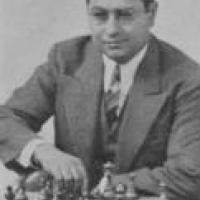
K + P vs K endgames
Irving Chernev (January 29, 1900 – September 29, 1981) was a prolific Russian-American chess author. He was born in Pryluky in the Russian Empire(now in Ukraine) and emigrated to the United States in 1920. Chernev was a national master strength player, and was obsessed with chess. He wrote that he "probably read more about chess, and played more games than any man in history." Chernev's deep love for the game is obvious to any reader of his books. He wrote 20 chess books, among them: Chessboard Magic!; The Bright Side of Chess; The Fireside Book of Chess (with Fred Reinfeld); The Most Instructive Games of Chess Ever Played; 1000 Best Short Games of Chess; Practical Chess Endings; Combinations: The Heart of Chess; andCapablanca's Best Chess Endings. In 1945, he and Kenneth Harkness wrote An Invitation to Chess, which became one of the most successful chess books ever written, with sales reaching six figures. Perhaps his most famous book is Logical Chess: Move by Move, first released in 1957. This takes 33 classic games from 1889 to 1952, played by masters such as Capablanca; Alekhine; and Tarrasch, and explains them in an instructive manner. Analgebraic notation version was published by Batsford in 1998, with minor alterations to the original text. Chernev died in San Francisco in 1981. SOURCE: http://en.wikipedia.org/wiki/Irving_Chernev
All of the compositions by Chernev are from his book "Practical Chess Endings" - see my review of it in my blog on endgames books.
These compositions are not in the exact order they should be, but anyone not able to solve all of them on the first try will learn a lot by playing through all of them even "out of order."
You can (and should) check out alternate lines of play by clicking the "solution" and then the "move list" buttons, even if you solved the problem yourself.
An apparently unsolvable chess problem here consists of trying to move the diagrams around (to put them in a certain order) everytime you add one to the blog, as the "place-holder" graphic doesn't represent the exact position or size of the diagram.

 NimzoRoy USA
NimzoRoy USA